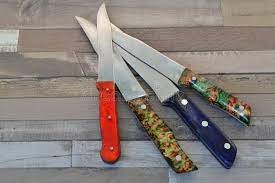Good knife care that helps to get the most from kitchen knives tips, Online home cooking tool sharpness advice
Tips for good knife care for kitchen knives at home
19 Apr 2021
You must maintain the sharpness of the edges of kitchen knives to ensure their proper functioning. Often some people might think that knives with slightly dull edge are safer to use as they fear that they could get hurt themselves by using sharp knives.
It is an entirely wrong perception about knives because the sharpness allows knives to work efficiently, and you can cut by applying minimal pressure that helps in better control of the tool. On the other hand, if you use dull Vertoku Knives, you have to apply more pressure, and there are high chances of the knife slipping and hurting you. Sharp knives help precision cutting and speed up work, whereas dull knives take longer to complete tasks with high chances of cutting your fingers. Although accidents can always happen, the cut caused by a sharp knife will heal faster and even hurt less.
Tips for good knife care that helps to get the most from kitchen knives
For using knives regularly, you must be familiar with the ways of taking its proper care for maintaining the sharpness by occasionally sharpening the edge whenever you feel that it has become dull. Take adequate care of knives that extends their longevity. Sharpening knives can happen in two ways: honing and sharpening, which are almost similar processes but with some subtle differences.
Difference between honing and sharpening
In most homes, you will find an accessory called a knife sharpener, a long piece of metal that looks like a sword. Although people call it a knife sharpener, the long and slender piece of iron is not a knife sharpener but instead an accessory for honing knives. Honing is a process of rubbing the knife against the iron plate so that it grinds the rough edges and helps to retain the sharpness but does not make it sharper. The process re-calibrates the knife to its default features in how it was molded at the time of fabrication by maintaining the proper angle of the edge, preferably set at 20 degrees. The honing process takes a little time, and you can do it several times between your work if need be.
How to sharpen your knife
While you can intermittently hone your knives, sharpening knives should be a half-yearly activity meaning you can do it twice a year provided you use it for regular cooking. To understand if it is time for sharpening your knife, try slicing a sheet of thin paper. If it cuts through smoothly, it means that the knife is sharp enough and does not need sharpening.
You can either sharpen your knife at home or get it done professionally. To sharpen knives at home, you must have a sharpening stone which is a cheaper option and even saves time as you can sharpen the knife at your convenience without topping work.
To ensure that your kitchen knives retain their sharpness longer, select the correct type of knife for any particular work by considering its suitability. Moreover, use the correct kind of chopping boards made from wood, plastic, bamboo, or epicurean material as it does not damage the sharp edge of knives.
Comments on this guide to Tips for good knife care for kitchen knives article are welcome.
Glasgow Building Designs
Glasgow Architecture Designs – architectural selection below:
New Passivhaus community campus in Faifley, West Dunbartonshire
Passivhaus community campus in Faifley
Prince & Princess of Wales Hospice Building
Prince and Princess of Wales Hospice Glasgow
Canniesburn Flats
Canniesburn Flats
Comments on this guide to Tips for good knife care for kitchen knives advice article are welcome

